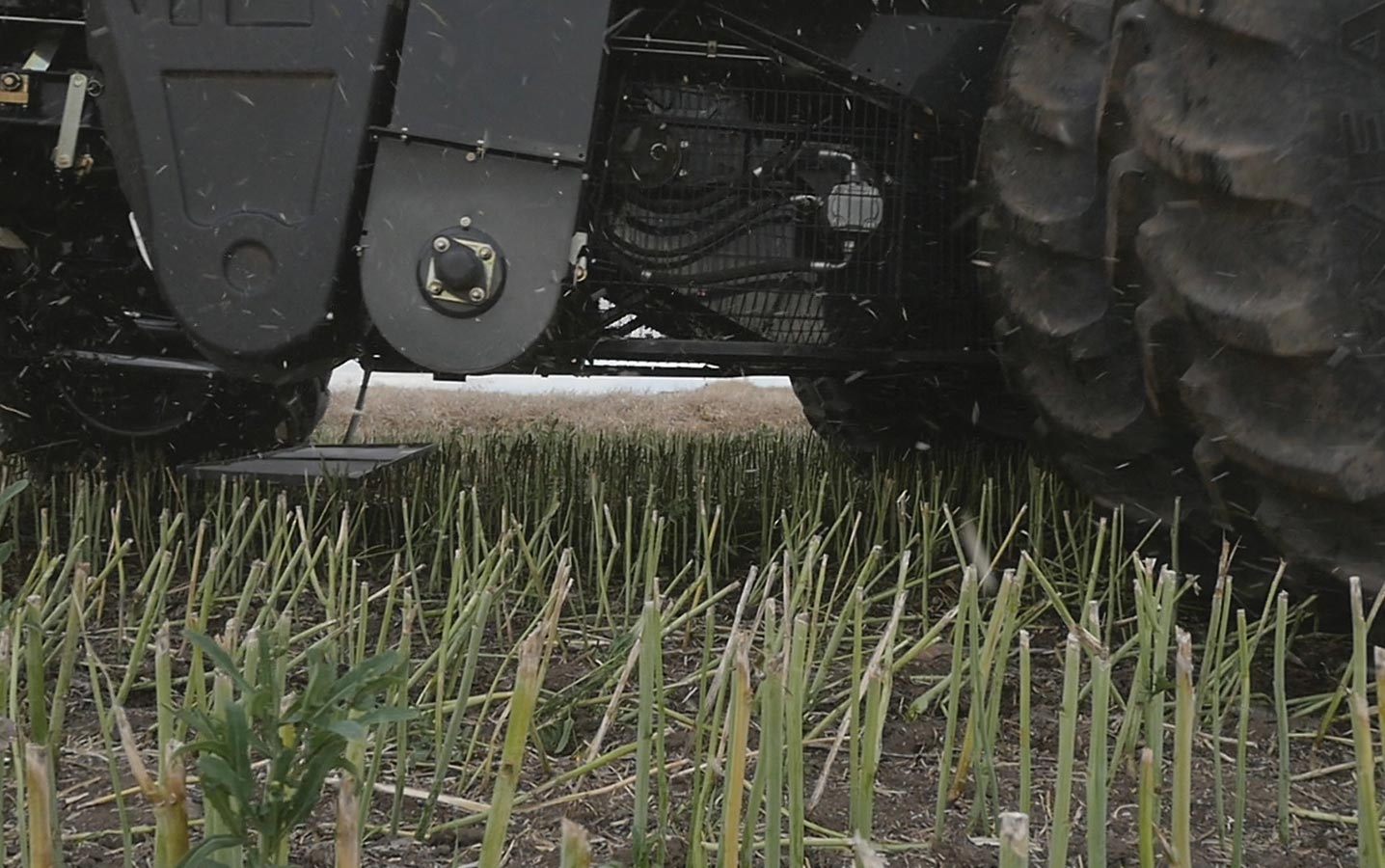How do you limit canola harvest losses?
 Ryan Vreeling
Ryan Vreeling
Hawk Hills, Alta.
Vreeling Farms uses kill stalls and drop pans a few times throughout harvest to keep canola harvest losses low.
“We try to be pretty anal about checking the combines,” Ryan Vreeling says.
“To make improvements, we’ll make one adjustment at a time so we know which ones are making a difference – otherwise we’re chasing our tails.”
He describes how to do a kill stall: “In order to perform a kill stall, you have to be combining crop at a normal load and speed. Once you feel like you are operating at a normal pace, pull the hydrostatic joystick back to neutral, stomp on the brakes as hard as you can and then throttle down. If you do these three steps all at once it will force the combine to stall. The reason we perform this is so that we can get a snapshot of our combine’s separating system when under load. The main thing you look for when you do this test is an even bed of chaff/seed across the sieves. If the material is piled up on one side of the sieves it’s a good indicator that your rotor speed is either too slow or too high (depending which side the material is piled up on). Another thing that would tip you off would be if your sieves were too clean. That more than likely means your fan is set too high and is blowing all the chaff/seed out the back of your combine.”
The Vreelings do kill stalls a couple of times per year per combine. “To make improvements, we’ll make one adjustment at a time so we know which ones are making a difference – otherwise we’re chasing our tails,” he says.
Their drop pan is the electro-magnetic ScherGain model, which they bought online after seeing an advertisement on Twitter for a Regina farm show. After clicking the sensor to drop the pan, they pour canola from the drop pan into the ScherGain calibrated measuring container to check the losses. “We’re trying for one bu./ac. loss but we haven’t been able to quite get there,” Vreeling says.
The Vreelings straight-combine canola using MacDon draper headers with pea augers at the top to improve canola flow into the feederhouse. Vreeling thinks the draper header probably reduces loss versus an auger header, but he’s not sure whether the pea auger at the top and the standard hoop dividers on the side help or hinder losses. “I have heard of some people using vertical cutters instead of the standard hoop dividers but I don’t think the price justifies the amount of canola it saves you. Any losses at the header wouldn’t show up in the drop pan so it is also hard to catch such losses,” he says.
Vreelings combine canola at around 4.5 mph, a speed that balances harvest efficiency and keeps losses close to their one bu./ac. target.
 Dan Holman
Dan Holman
Luseland, Sask.
A few years ago the Holman farm had a grad student come out to check canola fields for losses. The student was doing a thesis on canola losses and vacuumed up random areas of the fields after harvest. A few of their fields that fall had losses of less than one bu./ac. The highest was close to four. Dan Holman says some of those losses were from swaths shelling in the wind, but combine losses, which vary by year, variety, field and time of day, can be a major contributor.
“It’s tempting to try to clean up the sample by closing the bottom sieve. But if you get too much canola in the returns, it overloads the top sieve too much and chucks it out the back. As a result, we live with a bit more chaff in
the sample.”
The Holmans solicit opinions and try to attend a combine clinic every year to learn how to be better. “We used to always use a little yellow pan that the Canola Council sold to measure losses. I would wait for the combine to go past and then chuck it underneath and then weigh the sample. It worked OK, but was dirty,” he says. So, last year they bought one of Trevor Scherman’s ScherGain magnetic drop pans. “It was easier to use and caught a wider area of the combine,” Holman says.
Based on drop-pan measurements and kill stalls, Holman knows their combine will over-thresh in dry conditions. “When this happens, a large amount of the straw ends up on the top sieve and then the combine really chucks the canola out the back because the sieves are overloaded,” he says. “We keep an eye on that and when it starts to happen, we slow the rotors, open the concave and slow the ground speed.”
He says it’s tempting to try to clean up the sample by closing the bottom sieve. “But if you get too much canola in the returns, it overloads the top sieve too much and chucks it out the back. As a result, we live with a bit more chaff in the sample.”
From his monitoring, Holman also knows that when straight cutting canola, it can be easy to under-thresh canola and throw pods through the chopper that are still attached to the plant.
“It’s hard to always get the combines perfect, but ideally we want losses to be less than a bushel per acre,” he says. With the price for new combines, he thinks losses should be zero.
“I think it is very disappointing how as combines advance in price they don’t advance in canola loss performance,” he says. “To me, something that costs north of $500,000 should not be losing over $300 of canola per hour.”
 Colin Penner
Colin Penner
Elm Creek, Man.
Colin Penner doesn’t like having to run behind the combine to check for losses. So he built his own drop pan. It connects to the underside of the combine with electro-magnets and has a remote trigger to disengage the magnets and drop the pan. He will use it for the first time this harvest.
“The biggest thing in eliminating losses is to just slow down, even if we don’t touch any other settings on the combine.”
Unlike with a pan on a stick, with this pan he’ll be out of the dust and away from the combine operator when sifting through the discharge sample. “It’s not fair to the operator to have people running around the combine,” he says.
Penner doesn’t think they’re losing that much out the back of the combine, but what is the real number? How does it change by conditions? And how much is too much? The drop pan will help him answer those questions. “I’d prefer to see nothing come out the back, but that’s not a reality,” he says.
“The biggest thing in eliminating losses is to just slow down, even if we don’t touch any other settings on the combine,” Penner says. One challenge is getting his mom, who drives one of his two combines, to throttle back. “My mom keeps the trucks rolling and everyone else on task during harvest. In the combine, she likes to put the hammer down and go, which means she’ll be at six to eight mph when, in canola, I’d like her to be going four mph.”
Some evidence from the drop pan might help him convince her.
A question for Penner is: Why build a pan when he could just buy one? Lots of people are making electro-magnetic drop pans just like his.
His answer: “I can spend $1,500 to $2,500 for a similar system that is calibrated and works, and I know it would pay for itself quite easily. It just takes 1.5 bu./ac. saved on one quarter of canola,” he says. “But I knew I could build one myself, and I like tinkering. It’s fun to have that know-how and by working through the calibration process, I learn a lot about losses. That’s good for me and my farm.”
 Robert Paulow
Robert Paulow
Hafford, Sask.
Up until a couple of years ago, Robert Paulow used what was a fairly common technique to check canola losses: He blew on the ground to remove chaff cover and tried to count the tiny black seeds scattered over the black earth.
“It was a crap shoot. How many seeds are really there? How many is too many? It was like combining with my eyes closed,” Paulow says.
“At (four mph), our two combines can still cover a decent amount of acres and keep losses at a level where I’m happy. We could go faster and finish three days earlier, but would it be worth all the lost crop?”
So he starting applying the Prairie Agriculture Machinery Institute (PAMI) and Canola Council of Canada (CCC) methods, using a drop pan and digital scale to quantify the loss. One important discovery was how much his losses varied throughout the day. When swaths were tougher in the morning and in the evening, losses tended to be higher – even up to five bu./ac. in places, he says. Mid-day when swaths were dry, losses could be down in the one bu./ac. range.
Paulow also used kill stalls to see what was really happening in the combine. When combining along in a decent swath, he quickly shifted the throttle to neutral and shut everything down before the combine had a chance to process it. Then he looked in the back to see how material looked over the sieves. With the kill stall, he learned that leaving the same settings all day long meant he was over-threshing in the middle of the day. Sieves were overloaded with small pieces and he could see canola seed riding along on top.
“You just know that canola is going over the back,” he says.
These tests got him into a rhythm. In the morning and evening, he uses a tighter concave setting and higher rotor speed. As the day warms and the dew dries, he’ll open the concaves and reduce rotor speed. He also knows now that on really hot, dry harvest days when canola has cured to five to six per cent moisture, “we see a bit more losses because the seed is lighter.”
Paulow likes to combine canola at four mph. “At that speed, our two combines can still cover a decent amount of acres and keep losses at a level where I’m happy,” he says. “We could go faster and finish three days earlier, but would it be worth all the lost crop?”
Do you have feedback on the farmer panel? Do you want to participate in a future farmer panel? If yes, please email the editor, Jay Whetter, at whetterj@canolacouncil.org
Paulow talked with PAMI harvest researcher Nathan Gregg at canolaPALOOZA in Saskatoon in June. One thing they talked about was lifting the chopper/spreader to get a more accurate reading. Paulow hadn’t been doing that because it took more time, but Gregg explained how a drop pan reading in this situation might be skewed by an inconsistent spread pattern. So this year Paulow will disengage the choppers twice a day to take his drop-pan measurements.
“It will take a bit more time, but will be worth it if it improves the return for canola,” he says. More accurate loss measurements taken a couple times per day throughout each harvest will also help him calibrate what the combine loss monitors are telling him.
Paulow knows he has more to learn about combine settings and monitoring to reduce harvest losses, but he says, “I’m doing 10 times more now to prevent loss than I was three years ago.”





